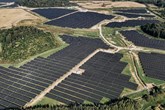EnBW commissions solar park aspect of new energy park in Germany
Published by Abby Butler,
Editorial Assistant
Energy Global,
EnBW has commissioned the 58 MW solar park aspect of new energy park in Germany.
The CEO of EnBW, Georg Stamatelopoulos, has opened the solar park in Gundelsheim alongside Thekla Walker, Baden-Württemberg’s Environment Minister. The photovoltaic (PV) power plant has an installed capacity of 58 MW, making it the second largest in Baden-Württemberg.
A new kind of hybrid battery storage system is also being installed on the site. Two wind turbines make up part of the plans, with the approval process already underway. The storage system also allows power to be fed into the grid more in line with demand. In total, the 64-hectare energy park will be able to generate as much electricity annually as around 30 000 households consume in the same amount of time. Boasting approximately 110 000 PV modules, the solar park extends over 55 hectares.
Georg Stamatelopoulos, CEO of EnBW, commented: “First of all, I am extremely pleased that EnBW will achieve its highest expansion in renewables in 2025. This applies to Germany as a whole and also to Baden-Württemberg. This means this is a record year for us, and this particular project is a great example of how a site can benefit from multiple renewable technologies. The onsite storage facility represents the possibility of storing excess electricity and feeding it back into the grid when needed.”
Stamatelopoulos continued: “Battery storage helps to match the weather-dependent generation of renewables with actual demand in the short term. Together with hydrogen-ready gas power plants, which are especially necessary for longer periods such as dark doldrums, they provide the flexibility in the system that we need. With the right mix and sizing, a holistic energy system is created that balances cost efficiency, reliability, and sustainability.”
Thekla Walker, Baden-Württemberg’s Minister for the Environment, Climate Action, and Energy Affairs, added: “This project is a prime example of how we are speeding up the expansion of low-cost renewable energy and making efficient use of existing resources. The location will combine solar and wind energy on one site with a common substation, helping to save grid connection costs. Future storage systems will optimise the feed-in process based on demand. The planned use of used electric car batteries in the battery storage system demonstrates that renewables are also leading the way when it comes to recycling and resource efficiency.”
The batteries have been sourced from twelve Audi e-tron vehicles, giving them a second life as a static storage system. They work in tandem with a new kind of sodium-ion storage system with a capacity of around 1 MWh, making it the largest installed battery featuring this technology in Europe right now. Together, both storage systems boast an output of 1.22 MW and a total capacity of 2.25 MWh. For context, the storage system can supply the amount of electricity consumed by the equivalent of around 3400 households for two hours.
The storage system is designed to make the process of feeding power from the energy park into the grid more flexible while also covering the site’s own needs. In combination, the new storage system draws on the strengths of both technologies: the lithium-ion batteries from the vehicles are suitable for fast charging and discharging, while the sodium-ion batteries are renowned for their stable and long-lasting output as well as the wide availability of the raw materials needed to produce them. The partner in the research project, Fraunhofer ISE, is developing and realising the energy management system needed to ensure the optimal coupling of the technologies. At the same time, research is being conducted into the use of the technologies and how they interact under real operating conditions. The research project is being funded by the German Federal Ministry for Economic Affairs and Energy.
The town also benefits from the solar park – in addition to the income raised from trade tax, it also receives rental income because it owns the site. Environmental associations were also heavily involved in the planning, and EnBW has put various conservation measures in place. These include a wide wildlife corridor, strips of wildflowers as well as fallow strips, planted using seeds from the region, and the preservation of old grasslands. The existing fire pond has been given an environmental upgrade and provides a valuable habitat for various native plants and amphibians.
For more news and technical articles from the global renewable industry, read the latest issue of Energy Global magazine.
Energy Global's Autumn 2025 issue
Explore the latest insights into the renewable energy sector in the Autumn issue of Energy Global, out now! This edition features a regional report on the Asia Pacific from Aurora Energy Research, mapping out why the wholesale price cap is detrimental to the energy transition in India. The issue then delves into articles covering crucial topics such as digitalisation in renewables, inspection & maintenance, developments in floating offshore wind, coatings, solar optimisation and more. Contributors include Flotation Energy, DNV, Sarens, Neuman & Esser, Teknos, and more, so this issue is not one to miss!
Read the article online at: https://www.energyglobal.com/wind/23092025/enbw-commissions-solar-park-aspect-of-new-energy-park-in-germany/
You might also like
Ignitis solar farms reaches commercial operation
Ignitis Renewables’ 72.5 MW Stelpe solar farm II has reached the commercial operation date.

